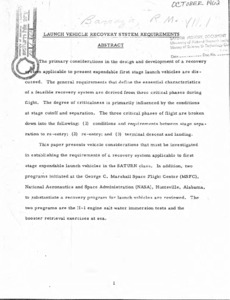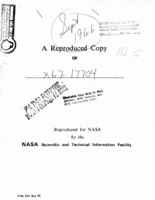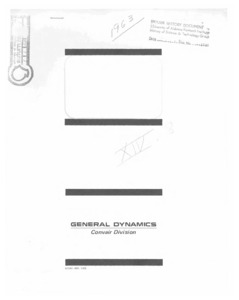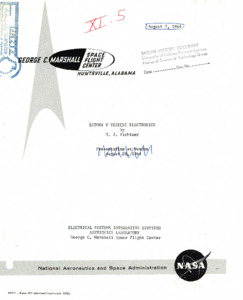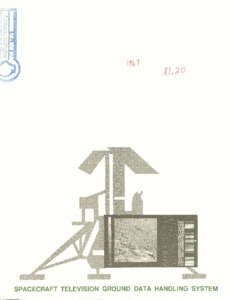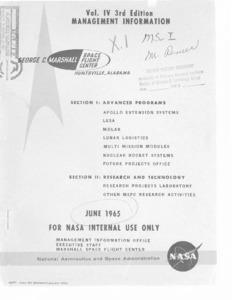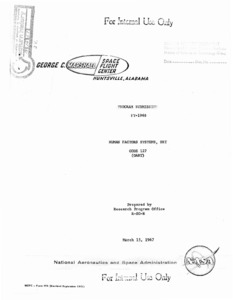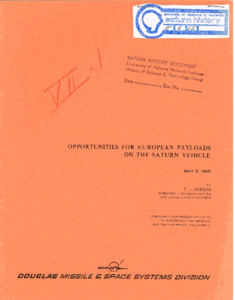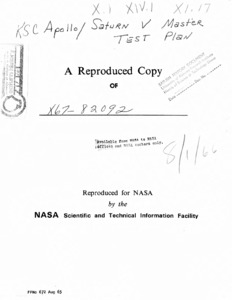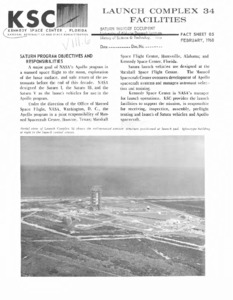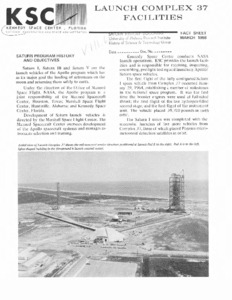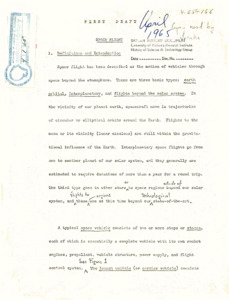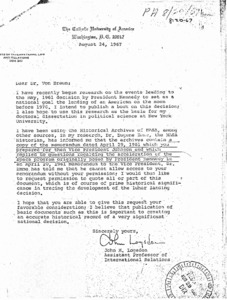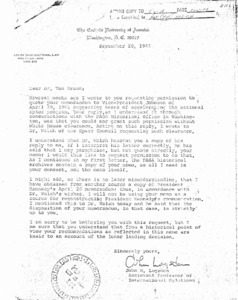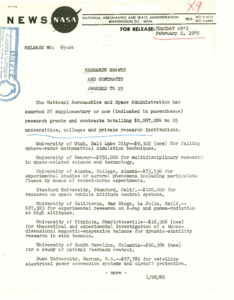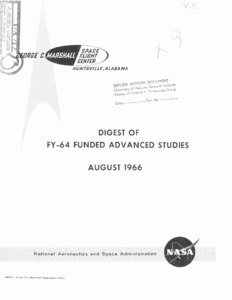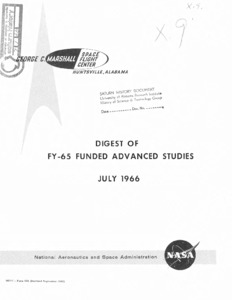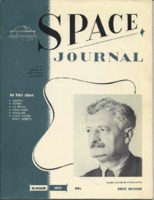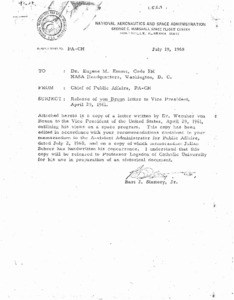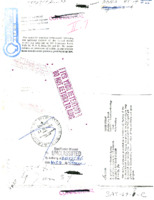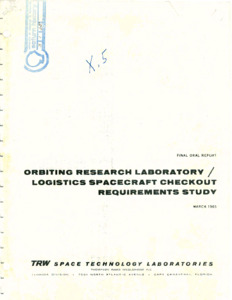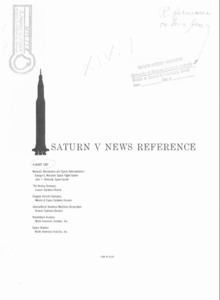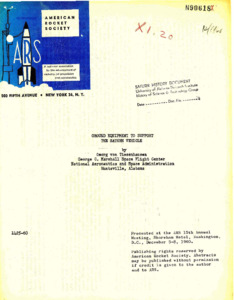
Browse Items (29 total)
Sort by:
-
"Launch Vehicle Recovery System Requirements."
The primary considerations in the design and development of a recovery system applicable to present expendable first stage launch vehicles are discussed. The general requirements that define the essential characteristics of a feasible recovery system are derived from three critical phases during flight. The degree of criticalness is primarily influenced by the conditions at stage cutoff and separation. The three critical phses of flight are broken down into the following: (1) conditions and requirements between stage separation to re-entry; (2) re-entry; and (3) terminal descent and landing. -
"Application of the Saturn V Launch Vehicle to Unmanned Scientific Exploration of the Solar System."
According to the foreword, "This paper presents the results of a twelve-week mission and systems analysis of a combined Jupiter orbiter/solar probe mission utilizing the Saturn V launch vehicle." -
"NEXUS concept of a large reusable earth launch vehicle."
Aspects of Earth-to-orbit delivery are discussed and a cost analysis of the logistic operation and the cost of orbital operations are presented. Probabilities of success of orbital delivery and the operational and economic aspects of establishing large orbital installations and maintaining a large transportation volume in the 1975/85 time period are compared for the two cases using a large number of Saturn V versus a smaller number of 1-stage chemical Post-Saturn launch vehicles. Performance parameters of chemical, chemonuclear and nuclear launch vehicles are compared. The concept of a blunt launch vehicle configuration referred to as NEXUS is presented in detail. Applications of this configuration to chemonuclear propulsion and to a 50 ft diameter version of Saturn V with recoverable first stage are discussed. -
"Saturn V vehicle electronics."
This presentation is a review of the electrical and electronics systems of the Saturn V launch vehicle. Since airborne and ground electronics cannot be separated as a system, this presentation will touch upon both the airborne and ground checkout equipment. Certain airborne electronic items are singled out in order to elaborate upon the application of computers for checkout and launch. This review covered in a broad sense such airborne electronics as the control computer, the measuring telemetry and RF systems, the switch selector, the digital command receiver and the remote automatic calibration system. The ground support equipment electronics covered include such equipment as the data link, computer system and display systems. The importance of software in the Saturn V program is stressed by the application of a standard program language through the use of acceptance test or launch language (ATOLL). -
"Saturn V vehicle electronics."
This presentation is a review of the electrical and electronics systems of the Saturn V launch vehicle. Since airborne and ground electronics cannot be separated as a system, this presentation will touch upon both the airborne and ground checkout equipment. Certain airborne electronic items are singled out in order to elaborate upon the application of computers for checkout and launch. This review covered in a broad sense such airborne electronics as the control computer, the measuring telemetry and RF systems, the switch selector, the digital command receiver and the remote automatic calibration system. The ground support equipment electronics covered include such equipment as the data link, computer system and display systems. The importance of software in the Saturn V program is stressed by the application of a standard program language through the use of acceptance test or launch language (ATOLL). -
"Spacecraft television ground data handling system."
A design report which displays and explains how the Spacecraft Television Ground Handling System functions, is designed and what it might be used for in the future. -
"Vol. IV 3rd edition Management Information."
This document contains copies of management charts and photographs maintained in the Management Information Office of the Executive Staff on Advanced Program and Research and Technology Areas. -
"Human factor systems."
Reports and resumes detailing funds, guidelines and assets. -
"Opportunities for European Payloads on the Saturn Vehicle."
Prepared for presentation to the Eurospace Conference. In this paper, we will not deal with the first two questions, which must be of interest to every potential experimenter, but only with the last question of vehicle availability. -
"KSC Apollo/Saturn V Master Test Plan."
The John F. Kennedy Space Center (KSC) Apollo/Saturn V Development/Operations Plan, K-PM-0, establislies the requirement for an Apollo/Saturn V Master Test Plan (MBP). This document, prepared by the Saturn Systems Office. -
"Launch Complex 34 Facilities Fact Sheet 05."
Article detailing the different aspects of the Launch Complex 34 facilities. -
"Launch Complex 37 Facilities Fact Sheet."
Article detailing the different aspects of the Launch Complex 34 facilities. -
"Report to the Congress from the President of the United States"
A report to Congress from White House regarding the accomplishments of NASA. -
"Space flight : first draft."
Appears to be a rough dfraft with editorial comments and revision notes. Includes references to figures and tables.; Page 31 is missing. Pages 37 through 44 do not exist; there is a note about this on page 36. Page 67 also does not exist. -
"Letter to Dr. Wernher von Braun."
Letter to Wernher von Braun from John M. Logsdon asking that Braun approves a request to quote his memorandum in his book. -
"Letter to Dr. Wernher von Braun."
Letter to Wernher von Braun from John M. Logsdon reiterating his request to use Braun's memorandum in his book as well as apologizing for any miscommunication. -
Oral History Interview With Robert McBrayer
After Robert McBrayer graduated college, he reported to the Johnson Space Center in March of 1963. He was there assigned to a section called "Biodynamics" and in that section, they worked on Human tolerances to impact sustaining acceleration and acoustics. Robert was assigned to the acoustics group, and his first job was to design and develop a machine to produce low-frequency pure tones to test humans. He also designed and developed a test chamber for testing humans, and he participated in doing the actual human test with the machines that he helped build. He helped document the results as well. After his venture in doing basic research, he went into an area called "crew's survival equipment design and development," and he was assigned pieces of equipment that were his to design, update, and help build. In 1966, Robert asked to be transferred from the Johnson Space Center to the Marshall Space Flight Center, and he then moved to Huntsville, AL. Robert was immediately put on the Orbital Workshop where they were writing task analysis, and procedures for crew station reviews. They did two of those, on in 1967 and the other in 1968. From the Orbital Workshop, he was responsible for all the crew interfaces on adapter, etc.Tags Oral History -
"The Saturn launch vehicle family."
Presentation focusing on the history of Saturn V's engineering history and crew. -
"Research grants and contracts awarded to 25 : NASA news."
Press-release detailing 27 research grants sent to numerous universities. -
"Digest of FY-64 Funded Advanced Studies: August 1966."
This paper outlines the major advantages of digital transducers and describes the principles and features (1) direct digital transducers, (2) indirect digital transducers, (3) quasi-digital transducers, and (4) A to D transducers. The mutual effect of transducers and systems will be discussed briefly, and some trends of transducer research and development will be presented. -
"Digest of FY-65 Funded Advanced Studies:July 1966."
This publication is one of a planned series to summarize the advanced study program for each fiscal year beginning with FY-61.A separate report will cover the study program for each fiscal year. The purpose of these documents is to provide reference information which should be helpful in planning future study programs. The FY-65 funded studies are covered in this document. These investigations are covered under four major headings: Launch Vehicle Studies, Earth Orbital and Lunar Studies, Planetary/Nuclear Studies, and AAP Studies. The information presented on each studyincludes a brief description of the objectives and pertinent contract data. -
"Digest of FY-66 Funded Advanced Studies: November 1966."
This publication is one of a planned series to summarize the advanced study program for each fiscal year beginning with FY-61.A separate report will cover the study program for each fiscal year. The purpose of these documents is to provide reference information which should be helpful in planning future study programs. The FY-65 funded studies are covered in this document. These investigations are covered under four major headings: Launch Vehicle Studies, Earth Orbital and Lunar Studies, Planetary/Nuclear Studies, and AAP Studies. The information presented on each studyincludes a brief description of the objectives and pertinent contract data. -
Oral History Interview With Joe Phillipauldy
Joe Phillipauldy is originally from Central, New Jersey. He did his undergraduate training at the University of Richmond in Virginia, and then he received his Master's degree at Villanove University. He then when on to get his graduate degree, and completed the program in 1984. His degree was in Experimental Psychology. In 1986, he accepted a job position with the Creatis Systems Tech Staff at Boeing Military Airplanes in Kansas. His first Human Engineering job was with Tech Staff. A project he spent a lot of time on was the Airforce I VC25 747 Presidential Replacement Program. With this, he did a workload analysis of the navigator crew station. After this work, Joe got involved with the Human Factors and Industrial Applications group. There, he ran task terms around the factory floor doing analyses and reporting on ergonomics issues on assembling vehicles. Later, he was able to work on the Space Station Vehicle Integration Contract in Huntsville, AL.Tags Oral History -
Space Journal, vol. 1, no. 1., Summer 1957.
This issue of Space Journal includes articles written by Fred L. Whipple, Hermann Oberth, and Ernst Stuhlinger, as well as a foreword by Wernher von Braun. The issue also includes drawings for an observatory to be built at the top of Monte Sano Mountain in Huntsville, Alabama. Produced by the Rocket City Astronomical Association (now known as the Von Braun Astronomical Society), Space Journal was published in Huntsville from 1957 to 1959. This digitized copy was generously provided by Jeff Bennett at the Von Braun Astronomical Society (VBAS). -
"Memorandum to Dr. Eugene M. Emme, Code EH, NASA Headquarters, Washington, D. C. from Bart J. Slattery, Jr., Chief of Public Affairs."
Memorandum from NASA Chief of Public Affairs to Eugine M. Emme. States that a video from Wernher von Braun are included regarding his views on the NASA program. -
"Army Participation in the National Satellite and Space Program."
This paper, which was presented at a Semi-Annual Meeting of the American Rocket Society, traces the role of the United States Army in national space activities. Incorporated in the report are photographs illustrating the evolution of the satellite and space program. -
"Orbiting research laboratory/logistics spacecraft checkout requirements study."
This report presents the results of the study of Orbiting Research Laboratory and Logistic Spacecraft Checkout Requirements as they relate to prelaunch operations at MILA. The study was performed jointly by the Florida Division and the Systems Research and Analysis Division of TRW Space Technology Laboratories for NASA under the terms of contract NAS10-1076. -
Saturn V news reference.
This book is designed to serve as an aid to newsmen in present and future coverage of the Saturn IB in its role in the Saturn/Apollo Program and as a general purpose large launch vehicle. -
"Ground Equipment to Support the Saturn Vehicle."
With the advent of the first large space vehicle, the SATURN, the ground support equipment and launch facility designer is faced with the necessity of conceiving and building an unprecedented launch system concurrent with the vehicle development. The paper intends to present a comprehensive picture of the problems involved and how they are solved. It follows the SATURN through the various modes of operation such as transportation over land and water, checkout, handling and erection, propellant loading, and describes the facilities at the launch site.
